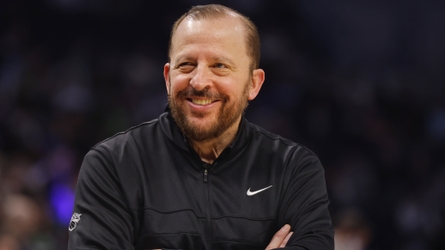The NBA trade deadline brought major fireworks across the league with numerous current and former All-Stars switching teams, but the Knicks (34-17, third in the East) largely stood pat after making all of their blockbuster moves this past offseason.
Their lone trade: sending Jericho Sims to Milwaukee for Delon Wright and cash.
Let’s dive into what New York did and didn’t do on deadline day and how it will impact the remainder of their season — and the summer to follow.
Those unsatisfied with Leon Rose’s relative inactivity (especially compared to his previous midseason moves) likely need a brushing up on the team’s cap and roster situation. Given how much equity they put into their starting five, it would be surprising to shake up their starters before they’ve played a playoff series together.
If a package based around OG Anunoby and Mitchell Robinson could net them LeBron James or Kevin Durant, that would be worth entertaining, but nothing of the sort emerged in rumors. Offering the same for Jimmy Butler or another lateral move would be an unnecessary risk as well.
New York has this core on the books for the foreseeable future, so barring embarrassing playoff exits or another major change, they’ll be working to boost the team on the margins before making a more material change. Unfortunately, it’s tough for them to even do that via midseason trade.
Assuming the starters were off-limits, that left Robinson, Precious Achiuwa, and Miles McBride as rotation players on above-minimum salaries available to deal. Sims, Cameron Payne, Tyler Kolek, and Pacome Dadiet could also be dealt, but they are on smaller contracts.
Robinson arguably carried the most value of the bunch with his $14-million deal and starter-level impact when healthy, but he wasn’t projected to bring anything of value back given his health concerns.
It’s hard to imagine much of a market was out there after Jonas Valanciunas was dealt for two second-round picks and other highly-shopped centers like Nic Claxton, Walker Kessler, Myles Turner, and Clint Capela stayed put.
Achiuwa, Payne, and McBride have been valuable bench pieces on team-friendly deals, and the rookies wouldn’t fetch much either. The Knicks also have little draft capital left to send out, with most of their assets being future second-round picks.
All this to say, the Knicks had very good reason not to go for a bigger move right now.
If they flame out in May, they’ll be able to reload in the summer having learned something about this team, but for now, a healthy Robinson may be a bigger short-term boost than most names dealt ahead of the deadline.
Onto what New York did get done: moving Sims for Wright.
The Knicks selected Sims with the 58th overall pick in the 2021 Draft, and he’s received ample opportunities to prove his worth during the three-and-a-half seasons since. He’s done so in some key areas — rim protection and rebounding — that made him more of a go-to option for Tom Thibodeau than most other young players.
Despite the double-digit starts in multiple seasons, Sims fell out of the rotation as often as he entered it, including this year. With his offense not really developing, the Knicks finding success between Achiuwa and rookie Ariel Hukporti while Robinson’s return nears, and Sims’s expiring this summer, a divorce at the deadline was inevitable.
Though he reportedly garnered some attention across the league, Sims wasn’t expected to return a needle-mover. That said, Wright has a chance to make the Knicks’ rotation with some added multi-positional depth.
Wright is a 6’5”, 195-pound ten-year veteran of the league who’s bounced around reserve point guard spots for nine different teams. He performed for most, and organizations simply moved in different directions, in the ilk of an Ish Smith rather than somebody washing out stop after stop.
Where he makes a potentially great fit is in his greatest skill — his defense.
His long wingspan makes him a pest for guards and a constant threat in passing lanes. Wright averages 2.1 steals per-36 minutes in his career. That kind of impact is sure to earn Thibodeau’s goodwill quickly should he get the chance and bring that defensive gusto.
Offensively, he’s not a very dynamic guard. He can bring the ball up, run your offense, and generate the occasional look for others, but this is where he lags behind other bench guards.
His three-pointer may be his biggest swing skill, having multiple seasons of 37 percent shooting from three but a handful of below average ones as well. He’s struggled in Milwaukee this season, shooting a career-low 24.5 percent from beyond the arc, but perhaps a change of scenery could help him turn things around.
It’s unclear if he’ll see minutes early on or if he’s resigned to being last year’s Shake Milton. His ceiling is likely supplanting Payne or Landry Shamet for spot bench minutes and getting some recurring action in the playoffs — where he’s had some positive experiences.
The choice was likely between a second-round pick and a fringe bench piece in return for Sims, and New York opted for an extra body that may be able to assist in their playoff chase. If that still isn’t enough, the good news is that the Knicks have the buyout market or G-League to fill their remaining roster spot.
The bad news is New York needs to wait until February 28 to sign somebody unless they rise into the second apron. Once that day passes, they can target a PJ Tucker or Daniel Theis or maybe call up TJ Warren from the G-League.
Ultimately, this trade deadline was a reflection of where the Knicks are vs. other teams. New York stood pat with Boston and Oklahoma City as fellow “contenders” with near-complete rosters, while other teams scrambled to buy and sell.
Let’s see if they truly belong in that class or if they’ll need to make up for their inaction in the offseason.
Read the full article here



